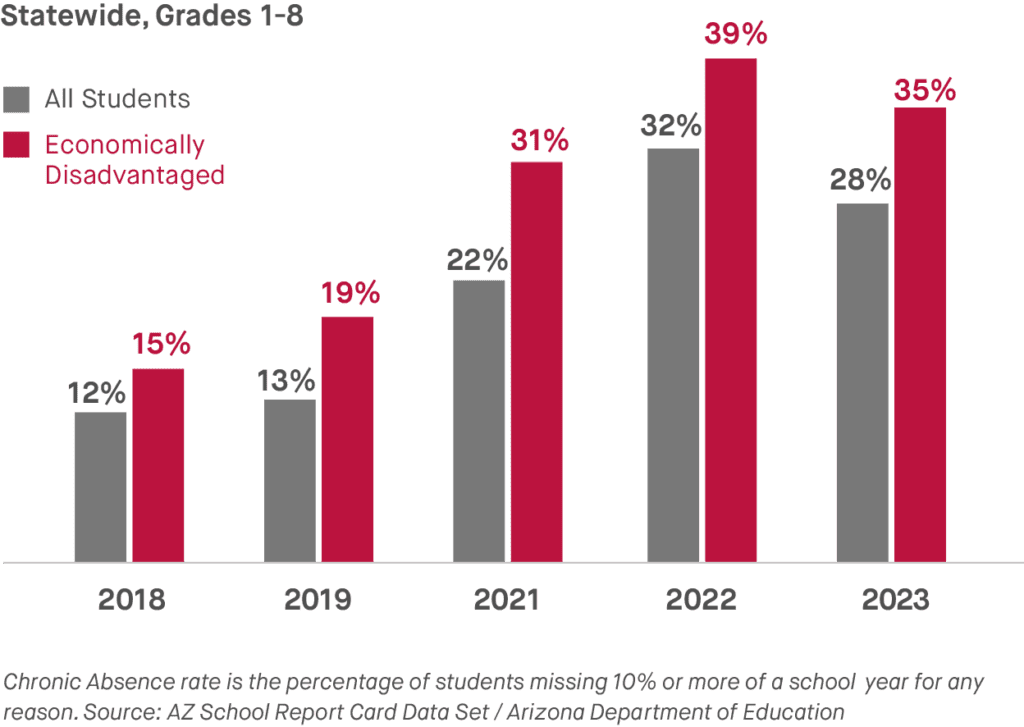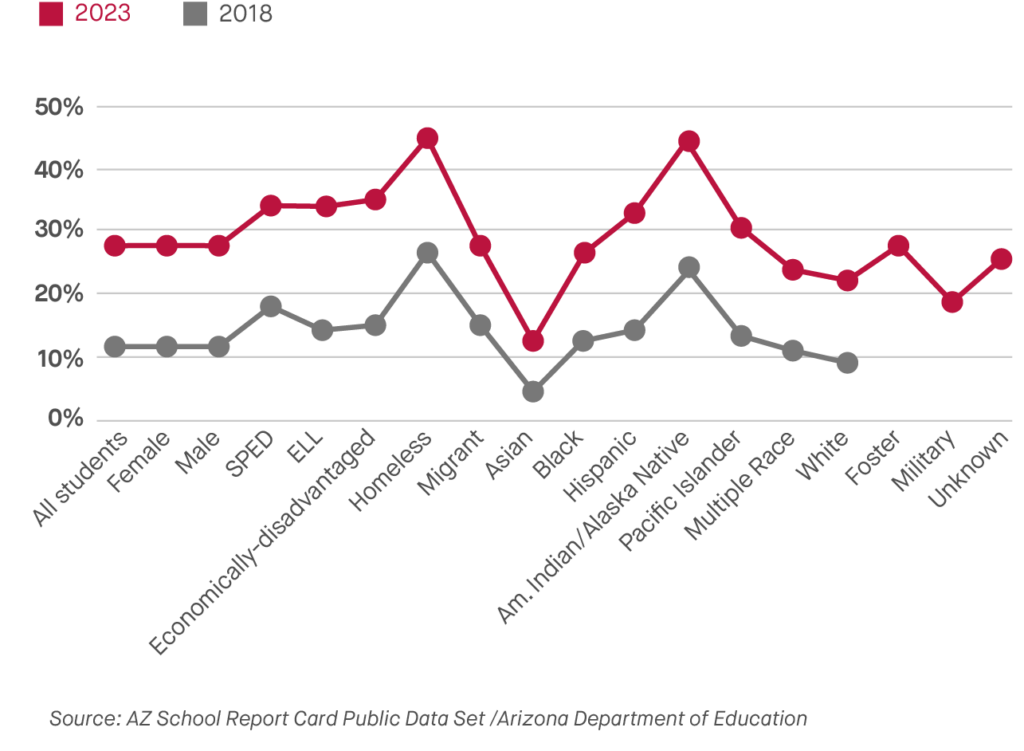Understanding Chronic Absence
Chronic Absence in Arizona
While not a new phenomenon, the scale of the chronic absence problem has grown exponentially in recent years, reaching levels that can negatively impact the learning outcomes we want for students in Arizona. Chronic absence is linked to decreased academic achievement at all grade levels, including an inability to read at grade level, lower graduation rates, and an increased likelihood of dropping out of school.
In addition, when the number of absent students increases in a class, the likelihood that other students will be absent increases. According to recent research from the University of Pennsylvania, when 10% of a student’s classmates are absent on a given day, that student is more likely to be absent the following day.
Arizona Chronic Absence Rate

- In 2018-2019, Arizona had a steady rate of chronic absence at 13% for students in grades 1-8. Only one in twenty Arizona schools had severe chronic absence rates, with 30% or more of their students chronically absent.
- In 2021, chronic absenteeism more than doubled. One in five enrolled students in grades 1-8 missed more than 10 percent of the school year. And, one in four of all Arizona public schools had 30% or more of their students chronically absent.
- In 2022, chronic absenteeism continued to rise, with one in three students chronically absent in grades 1-8, and 59% of schools throughout Arizona had 30% or more of their students chronically absent.
Chronic Absence Among Student Subgroups
While chronic absence increased for all student groups from 2018 to 2023 in Arizona, the highest increases were seen for student populations classified as economically-disadvantaged, English Language Learners, homeless, and for students identifying as Native American, and Hispanic.

In 2023, chronic absence rates were higher among homeless (45%) and Native American students (45%) than the prior year. In addition, the chronic absence rate for Hispanic students was 33%. In Arizona, nearly half of the total K-12 student population enrolled is Hispanic. These levels of chronic absence work against our efforts to close opportunity gaps for various student populations.
Chronic Absence and Mobility
Arizona serves transient student populations including students who lack stable housing and move frequently, students receiving migrant educational services, or military population families. Mobility can impact attendance.
When a student leaves one school district and enrolls in another, their chronic absence data resets. For example, a student who was absent nine days in one district and then ten days in another, would be chronically absent when looking at their attendance collectively for a school year, but would not show up as chronically absent for either district separately. It is important to be aware that this is an issue for some students.
Chronic Absence and Early Childhood
In addition to a substantial increase in chronic absence for students in grades 1-8, Arizona also saw a major increase in chronic absence for students enrolled in pre-kindergarten programs. In 2022, the chronic absence rate for students enrolled in pre-kindergarten programs was significantly higher than for students enrolled in K-8 schools.
Missing valuable instructional time in the early childhood years negatively impacts a child’s ability to read at grade level by the end of third grade. In addition, chronic absence in the early childhood years predicts future absenteeism as children progress through school. Children who are chronically absent in the preschool years are five times more likely to be chronically absent in the primary grades.
Suspension Policy
Some school districts have used out-of-school suspensions to discipline students for missing learning time. Looking at the efficacy and impact of policies that suspend students for missing class is an important part of the conversation to consider around chronic absence. Experts share that evidence shows that suspending students does little to alleviate the problem and can exacerbate underlying root causes of disengagement. Using suspensions in this way can increase the attendance problem the disciplinary action was intended to solve. The practice of using out-of-school suspensions for truancy is banned entirely or prohibited to some extent in several states now across the country.
City of Phoenix Head Start
Before the school year even begins, City of Phoenix Head Start kicks off efforts to raise awareness around the importance of attendance. According to Katie Perez, Family Engagement Specialist, “We know that starting the attendance habit in the birth to five years will set children up for success later in school.” Teachers provide orientations for parents about the expectations of daily attendance and highlight the connection between attendance, school readiness, and the achievement gap. Families are educated and engaged throughout the year. Perez shared, “After learning about how missing school in the early years can set children back, we’ve seen parents prioritize not having their children miss school. They’ll schedule doctor appointments outside of school time to ensure their toddlers and preschoolers are present and learning.”
During the first 20 days of school, staff review data to identify children who are chronically absent and intervene early. Data is pulled daily to identify levels of absence. Teachers and caseworkers work with families and use resources from Attendance Works to create an individual success plan to address barriers to attendance and effectively address the problem. Attendance campaigns are done before every break because children tend to miss more days around these times. Staff send personalized postcards home sharing that children are missed and that they’re looking forward to seeing them at the end of the break.
According to Perez, “We attribute our success to everyone’s dedication to the vision—from the director, case workers, teachers, family engagement staff, schools, service providers—and working together towards that common goal.” City of Phoenix Head Start has seen its chronic absence rate drop by 20% over the past two years.
What struck you most as you learned about chronic absence statewide? How do you think your school or district’s experience compares to the statewide data discussed here?
Resources
Ten Facts About School Attendance from Attendance Works
Absent Peers Present Challenges study
MapLIT is Arizona’s comprehensive data tool for interactive mapping and summary reports on key data including chronic absence
